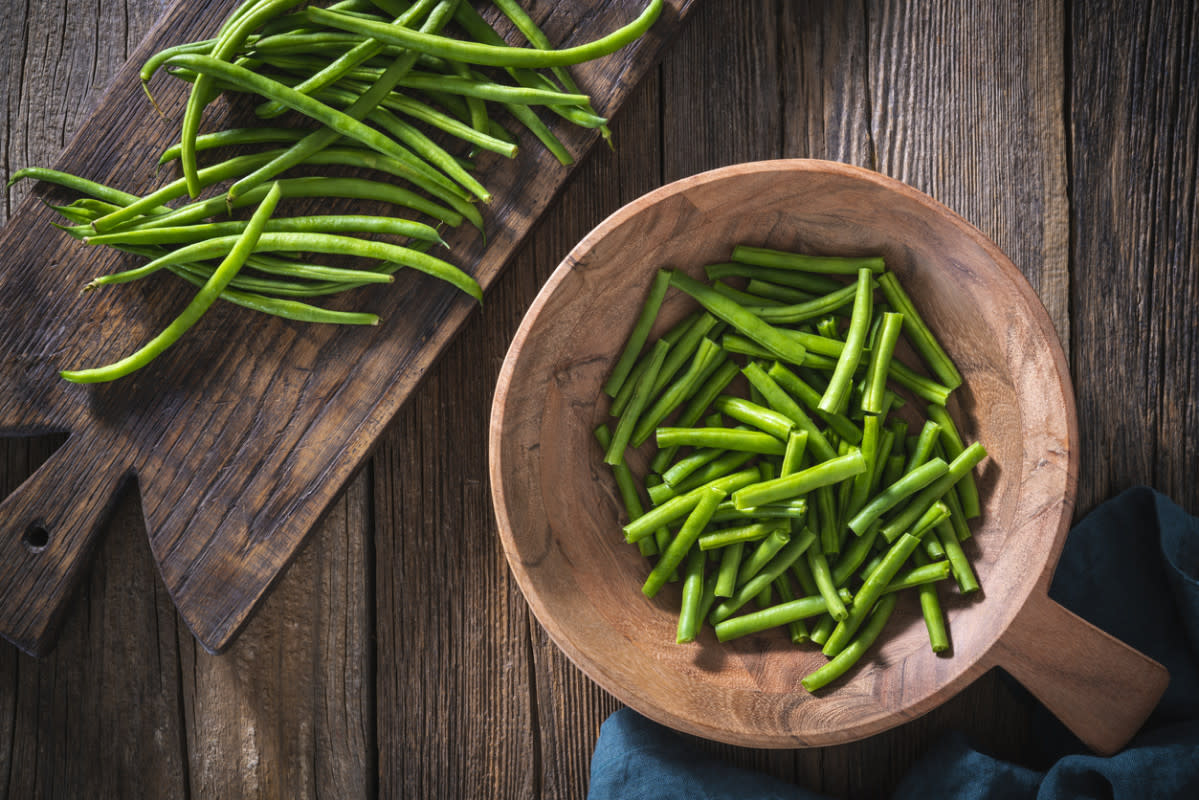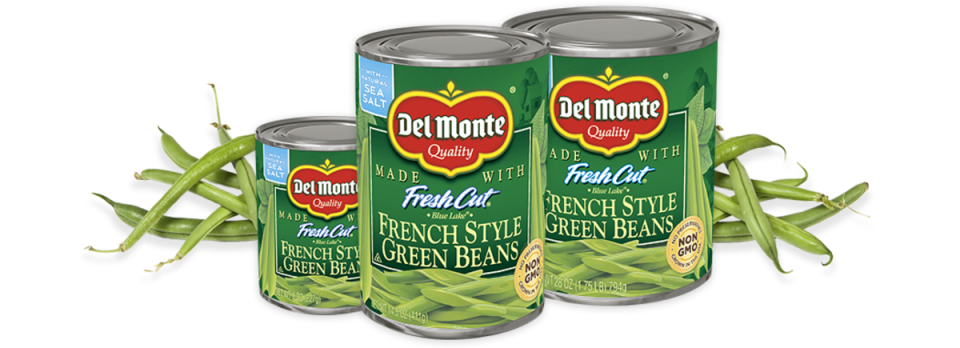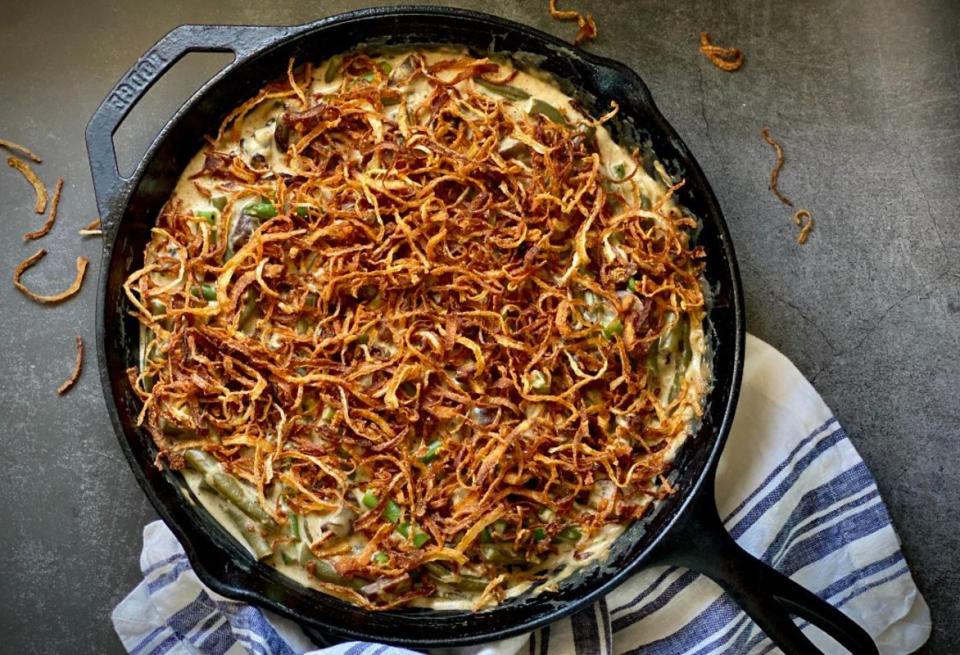The Humble Vegetable That's a Thanksgiving MVP

Green beans don't exactly make up the meat and potatoes of a feast like Thanksgiving. Literal factors aside, turkey and carby side dishes like mashed potatoes and stuffing (or dressing—you do you) often steal the show.
However, don't sleep on the green bean casserole. The creamy, savory dish is a classic for a reason. The secret sauce? It's not canned mushroom soup or the French's French Fried onions. Experts say it's a different ingredient with a French twist: French cut green beans.
If you're not a produce expert, you may not know much about French cut green beans, so we chatted with an actual produce expert, plus a few chefs, to suss out what you need to know about this fancy-sounding veggie.
Related: Maple & Orange Pecan Pie Takes the Classic Dessert in a Fresh New Direction

Del Monte
What Are French Cut Green Beans?
The answer to this question is pretty simple. "French-cut green beans are just regular string beans that are julienned, or cut into thin strips," says “Produce Pete” Napolitano, a renowned fruit and vegetable expert whose popular segment on Weekend Today in New York (WNBC) has aired on Saturday mornings for more than three decades. Napolitano recently published a memoir and cookbook, They Call Me Produce Pete, with co-author Susan Bloom.
The result of this slicing is a slim, Pinterest-worthy beauty of a green bean. You can buy them canned or frozen, or even make them yourself. Looks aside, experts love French cut green beans for casseroles and they're a great hack for busy cooks.
Why Are They Called French Cut Green Beans?
It's all about the technique. French-cut green beans start as whole ones. Then, they're thinly sliced horizontally, creating thin strands. "They were given the name because of the French style of cut," says William Gideon, the executive chef for CORSAIR Kitchen + Bar and JW Marriott Miami Turnberry Resort & Spa in Aventura, Fla. "It is an elegant finesse cut used for a sexier presentation and a faster cooking technique."
Do French-cut green beans sound high-minantence? Gideon insists they really aren't. "They really are easy to put together," Gideon says. "If you purchase them, you have achieved half the battle. They cook in half the time as regular cut green beans. The time factor is clutch for busy home cooks with every burner and countertop appliance running on the day of the big feast.
Related: This Classic Tuna Noodle Casserole Literally Tastes Like Your Childhood, Only Better
Do French Cut Green Beans Taste Different Than Regular Green Beans?
French cut green beans have a similar flavor to whole green beans. The main different is the texture. Because French cut green beans are sliced so thinly they cook up silky and tender. The slicing also turns the veggie from a tube to a strip, which helps the beans absorb the flavors they're cooked with (more on that below).

AltonBrown.com
Why French Cut Green Beans Reign Supreme In Casseroles
Let's start with speed. "French-cut green beans have less cooking time and therefore create a more tender result," says Michael DeLone of Nunzio by Chef Michael DeLone in Collingswood, N.J.
But it's not just efficiency that makes them a great choice for casseroles. "Because they are cut so thinly, they absorb more flavor as they are cooked or baked," Gideon says. "In most cases, you are not looking for al dente or undercooked beans. They are typically baked with many ingredients, achieving a wonderful flavor with a finish of crunch on top." Like French's French fried onions? You know it.
Although green bean casserole is likely the most common time you'll use French cut green beans, don't forget about them the rest of the year. Because they're quick-cooking they can make an easy side dish year-round.
Related: 27 Epic Thanksgiving Charcuterie Boards To Enjoy on Turkey Day
How to Make Your Own French-Cut Green Beans
You can buy pre-sliced French-cut green beans either frozen or canned, but you can also DIY them. Although you can slice them lengthwise with a knife, this is a time when it's smart to let a machine do the job, if you can. "The fastest way is to push them through the mouth of a food processor," DeLone says.
As food expert Jerry James Stone demonstrates below, it's as easy as trimming the green beans and putting them in the tube of your food processor parallel to the slicing blade. Push down and the machine slices the veggie into pretty strips. Now that's something to be thankful for!
French Cut Green Beans vs. French Green Beans
Now that you understand French-cut green beans, let's dig in further. Despite the similar-sounding names, French-cut green beans and French green beans aren't the same.
"French green beans, or haricot verts, are a more slender variety of traditional green beans, which are also called string beans here in the U.S.," Napolitano says. "Because they’re harvested earlier, haricot verts also tend to be more tender, earthier in flavor and more expensive than traditional green beans."
Grab some paper because Napolitano has a history lesson for you. "Native to South America, haricot verts were first introduced to France by Spanish explorers in the 1500s and really took hold there, hence the name ‘French green beans,'" Napolitano says. "Consumers will see many haricot verts coming from Guatemala at this time of year."
If you're cooking haricot verts (French green beans) for Thanksgiving or any time of year, you need to know how to cook them properly. "When preparing haricot verts, place them in boiling water until they’re barely tender [and] slightly crisp—just about 5 minutes—to avoid overcooking them," Napolitano says.
